#greg mayne
Explore tagged Tumblr posts
Text
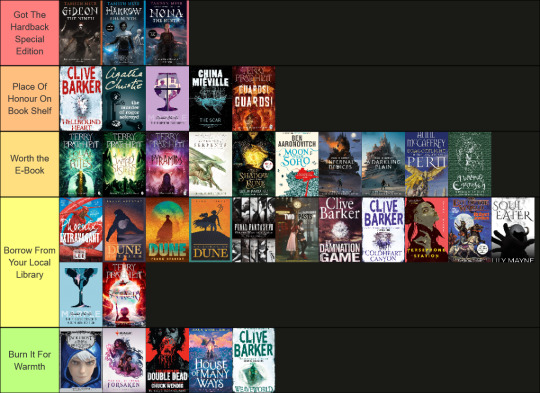
2023 Goodreads Reading Challenge Tier List!!!
Got The Hardback Special Edition - I don't like these books, I love them. It's not that I need the hardbacks, I need to devour the pages, so I can consume every bit of canon and then go diving into the fandom just to get my next fix (The Locked Tomb by Tamsyn Muir: Gideon the Ninth, Harrow the Ninth, Nona the Ninth)
Place of Honour on my bookshelf - I like these books and feel the need to display the paperbacks on my bookshelf, so guests know I have good taste :3 (Clive Barker - The Hellbound Heart, Agatha Christie - The Murder of Roger Ackroyd & The Thirteen Problems, China Mieville - The Scar, Terry Pratchett - Guards! Guards!)
Worth the E-Book - I'm happy I read these books, even though they were not necessarily in my top 10 this year. I will probably read them again in the future, so I'm happy to own them on my e-reader.
Borrow from your local library - I neither like nor dislike these books, they are perfectly serviceable, but I wouldn't spend money just to own then. (Yoon Ha Lee - Phoenix Extravagant, Frank Herbert - Dune, Dune Messiah & Children of Dune, Final Fantasy - On The Way To A Smile & Traces of Two Pasts, Clive Barker - The Damnation Game & The Coldheart Canyon, Stina Leicht - Persephone Station, Robert Jordan - The Eye of The World, Lily Mayne - Soul Eater, Terry Pratchett, Agatha Christie - The Mirror Crack'd From Side to Side, Terry Pratchett - Sourcery)
Burn for warmth - I actively disliked these books, or they were just so boring I had to take frequent breaks just to get through them (William Joyce - Jack Frost: The End Becomes The Beginning, Greg Weisman - The War of The Spark: Forsaken, Chuck Wendig - Double Dead, Diana Wynee Jones - House of Many Ways, Clive Barker - Weaveworld)
#personal#I read 36 books this year#so that's 3 books a month#I prefer a tier list ranking over a five star review system#as there are books I would give two stars to#not because they're bad#just because I feel no need to ever go back and re-read them
3 notes
·
View notes
Photo

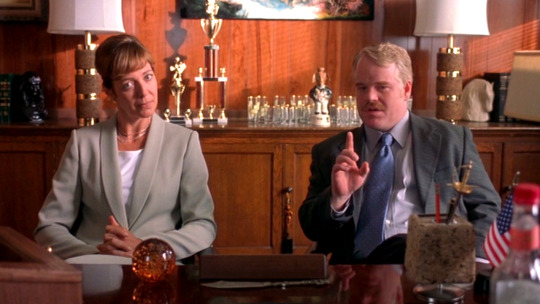
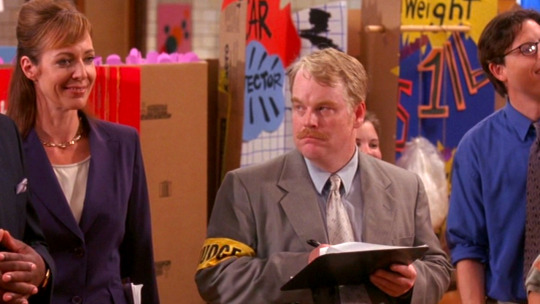

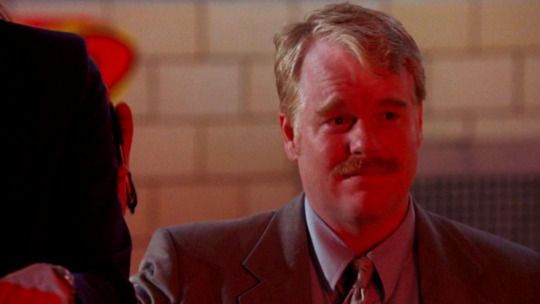
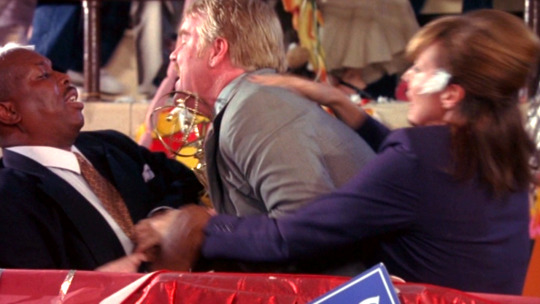

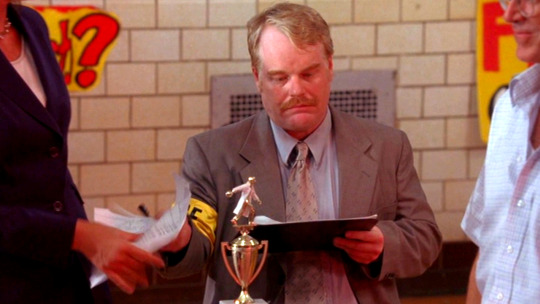

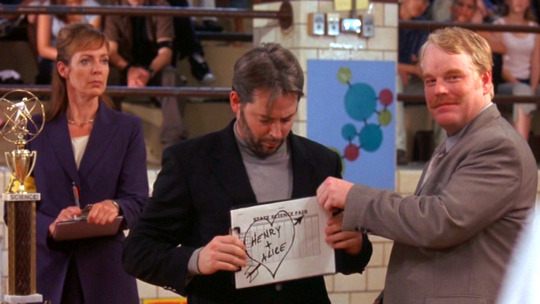
This week’s Monday Philm (on a Tuesday) is Strangers With Candy (2005), based on the eponymous TV show and one of my least favorite movies lmao. I like Amy Sedaris elsewhere but I never watched the show and it’s not really within my sense of humor, but it does get a few laughs, especially from PSH, Allison Janney, Greg Hollimon, and Stephen Colbert.
PSH’s deadpan performance as Henry is hilarious. There’s not too much to write—it’s a pretty small role that’s better seen that described—just that it’s fun to see Phil fucking around in a comedy with some of his friends, not taking anything too seriously. Funny that last week’s feature was Empire Falls because there are a few lines (especially in Principal Blackman’s office) where you can hear the same broad accent he used as Charlie Mayne lol. Perfect pratfall, precisely in frame, no notes. And I LOVE that little smile Henry/Phil gives when he takes his clipboard back from Matthew Broderick—it’s the blink of an eye but one of my favorite little flourishes he ever did.
I was so bored and I’d already gone through the hassle of getting the DVD to work on my laptop so I watched the commentary track with Amy, Stephen Colbert, and director Paul Dinello for Phil’s scenes. I was pleasantly surprised to hear the commentary actually did address one of the few questions I had about Strangers With Candy—what Henry writes on his clipboard that makes Alice clam up then announce the science fair winner herself. I’d wondered if Phil had actually written anything, and, much like how PTA shot the phone call scene in Licorice Pizza, Dinello says he told Phil to “write something that would offend her.” It’s too dirty to repeat here—even Amy and Stephen’s jaws’ drop when Dinello tells them on the track—but oh, what an awful filthy boy.
(Related, since this was their only film project together: I never realized Phil and Amy dated briefly in the 90s until someone said it plainly a few months ago, but in hindsight it is so clear. How did I not immediately know when she described playing this game with him: “I’d be like, You have to act like you passed out on top of me and I have to try to get out from underneath you without waking you up.” She is stronger than me bc I would never be the same.)
#without exaggeration I would empty my bank account for the chance to play that game just once#it would cure me#oh to date 90s phil and play silly parlor games and fuck him up with a cheap face mask and let him put his entire body weight on top of you.#her stories abt him are <3#monday philm#strangers with candy#philip seymour hoffman#psh#*#henry is soooo cute but he's probably like. one of the psh characters I think abt least 💔 sorry henry
7 notes
·
View notes
Text
youtube
Pentagram - Yes I Do
#pentagram#yes i do#bobby liebling#vincent mcallister#geof o'keefe#greg mayne#hard rock#doom rock#first daze here too: the vintage collection 1971-76#2006#Youtube
3 notes
·
View notes
Audio
7 notes
·
View notes
Text
No one:
My sisters and their friends in 2009:

#pentagram#bobby liebling#Vincent McAllister#Greg mayne#Geoff o’keefe#GET IT#drunk in the bathroom setting the camera on the sink takin selfie
6 notes
·
View notes
Video
youtube
Pentagram - Be Forewarned
#pentagram#pentagram band#be forwarned#first daze here#be forwarned album#bobby liebling#vincent mcallister#greg mayne#geof o'keefe#heavy metal#doom metal#music#music is love#music is life#music is religion#raining music
5 notes
·
View notes
Text
Dirty Amateurs➳ {L.S}
by poxiekitten
✰"I love you so much". He rubbed Harry's hands and said in a low dulcet voice, "Now I think you are a sign in my life that I must die if it is to disappear forever."
✰"I belong to you. You can do anything to me. Kiss me or you will own me forever." ~*~ ✰Louis Tomlinson, Eighteen years old, a schoolboy, is a strong, resilient, but a kind-hearted person. He plays very well in the game of football because he is very trained and his coach is so proud to have him on the team.
✰Harry Styles, Sixteen years old, is also a schoolboy and works as a cashier at the famous bakery called Mandeville. He is very soft-spoken and he treats everyone with great friendliness and gets acquainted so easily by his alluring face and the endearing talk.
✰They met each other one day and became closer, but that relationship became much greater more than that of intimacies. Some things also came off between them like hate and supports. Louis had a massive number of friends who also has the same amount of enemies too, But the fearless Louis, one day had an incident against him. And it brought great pain.
☀Will Louis get safe again? That's just a question mark for him. ☀
Words: 4835, Chapters: 4/?, Language: English
Fandoms: One Direction (Band)
Rating: Mature
Warnings: No Archive Warnings Apply
Categories: M/M
Characters: Harry Styles, Louis Tomlinson, Niall Horan, Zayn Malik, Liam Payne, One Direction (Ensemble), Simon Cowell, Olivia Wilde, Gemma Styles, Lottie Tomlinson, Tomlinson Sisters, The Styles Family, Trisha Malik, The Tomlinson Family, Phoebe Tomlinson, Daisy Tomlinson, Yaser Malik, Doniya Malik, Safaa Malik, Waliyha Malik, The Malik Family, Bobby Horan, Greg Horan, The Horan Family, Denise Horan, Félicité Tomlinson, Jay Tomlinson, Karen Payne, Geoff Payne, Nicola Payne, Ruth Payne, The Payne Family, James Corden, Eleanor Calder, Ed Sheeran, Shawn Mendes
Relationships: Harry Styles/Louis Tomlinson, Zayn Malik/Liam Payne
Additional Tags: Larry Stylinson Is Real, Ziam Mayne - Freeform, larrystylinson, harrystyles, louistomlinson - Freeform, liampayne, niallhoran - Freeform, zaynmalik, gaylove, bxb - Freeform, larry - Freeform, Styles - Freeform, tomlinson - Freeform, Payne - Freeform, Malik - Freeform, Horan - Freeform, simoncowell, Football, Bakery, Tragedy, holivia, Fanfiction, 1d, onedirection
via AO3 works tagged 'Harry Styles/Louis Tomlinson' https://ift.tt/3mWoBpN
2 notes
·
View notes
Text
@greg-multiverse saiyd fuhk so tate mayns I can say fuhk >:(
20 notes
·
View notes
Photo

Fresh off the holidays we're back with another episode mayne!
It was a pretty light week but we still delivered on some solid content to keep you guys entertained. For our What's On Your Mind segment @theanticool delivers us some horror stories from Reddit and I discuss my new addiction to vinyl. Afterward we move on to fight announcements and we give a few thoughts specifically on Leon Edwards Vs Tyron Woodley and Yorgan De Castro Vs Greg Hardy. On the fight side of things we start off with boxing and give our thoughts on the Gervonta Davis Vs Yuriorkis Gamboa which left us with a few questions about Davis. And to finish it all off we cover Bellator 237 which was headlined by Fedor Emelianenko vs Rampage Jackson and it was..........a fight that happened.
We hope you guys enjoy the episode. Don't forget to share with a fellow fight fan and we'll see you guys in 2020!
Time Stamps
Fight announcements (16:38) Edwards Vs Woodley thoughts (18:21) Jacare Vs Uriah Hall thoughts (22:21) De Castro Vs Greg Hardy thoughts (23:49) Khalil Rountree retiring (28:04) Patrick Cummins retiring (31:52) Gervonta Davis Vs Yuriorkis Gamboa (35:39) Bellator 237 (55:33) Where are the postlims? (1:37:26) Upcoming cards (1:46:36) Closing thoughts (1:51:01)
Soundcloud - http://bit.ly/33M0OOo Spotify - https://spoti.fi/2W6OjdL Apple Podcasts - https://apple.co/2o1iiHj Google Play - http://bit.ly/2VYV7cZ Youtube - http://bit.ly/32rME4C
Follow me on Twitter https://twitter.com/CerealSensei
Follow me on Twitch https://www.twitch.tv/cerealsensei
Follow Theanticool on Twitter https://twitter.com/gczeus
Buy my book The Oddball Chronicles https://amzn.to/2VVgHz6
#bellator 237#rampage jackson#fedor emelianenko#gervonta davis#yuriorkis gamboa#boxing#mma#dojo talk podcast
0 notes
Note
Honestly the entire original Pentagram lineup looked great, with Vincent McAllister, Geoffrey O'Keefe and Greg Mayne
ok so idk anything abt this band but I found this pic

and I’d def fuck all the three on the left no hesitation so I guess ur valid !
send me ur most shameful celebrity crush and I’ll tell u if it’s valid or not
1 note
·
View note
Link
For those of you who have ordered your Rugby Club sports jacket or waistcoat from Voodoo Sports, there will be a fitting taking place in the clubhouse on Saturday 16 February (home fixture against Birmingham & Solihull) between 12 midday and 3pm. James Linsell from Voodoo will bring some samples of other jackets purely for confirmation of sizes ordered, so there’s still time to lose those extra couple of pounds from Christmas or submit to the inevitable and add an inch or two. Any stragglers still wanting to buy from Voodoo can speak to James on the day or contact Greg Mayne ([email protected]) with size details.
The target is for these to be available prior to the sponsor’s match at the end of the season.
Greg Mayne
0 notes
Photo

Constructing a Dystopian World
A Conversation with The Thinning Director Michael Gallagher
A Conversation with The Thinning Director Michael Gallagher
The Thinning is a new YouTube Red Original Movie from Legendary Digital Studios starring Logan Paul, Peyton List, Lia Marie Johnson, Calum Worthy and Ryan Newman. Set in a future where population control is dictated by a high school aptitude test, two students must take down the system before it takes them first. We had the chance to sit down with Michael Gallagher, director of The Thinning, to talk about how he went about creating an original dystopian world from the ground up, what it was like working with Logan Paul, and what real world elements inspired the film’s design. See what he had to say below.
Q: Legendary has a history of putting an emphasis on “world building” and The Thinning very much follows that trend. Talk about what it was like creating an entirely original dystopian world from the ground up for this. Did you pull inspiration from any other dystopian/sci-fi/young adult geared stories or worlds to help you create this one?
MG: The movie is set in a sort of not-too-distant future / bizarro version of America— an authoritarian government runs all schools like prisons. The failed students are sentenced to death and passing students are thrown lavish parties. Designing the high security school was key. We have a fictional task force called the Department of Population Control— DPC for short. Showing a high school run by militarized guards forcing students into a scary TSA-style search really helped warn the audience that this is a new America. I was heavily inspired by paranoid thrillers of the 60’s and 70’s like The Parallax View and 3 Days on the Condor. I love movies following an innocent thrown into a conspiracy plot and having to prove that nothing is as it seems or they will lose their life in the process. I am also a huge fan of the social satires of John Carpenter, who is such a master at exploring current issues in a sci-fi setting and making them edge-of-your-seat, entertaining thrill-rides.
Q: The Thinning feels timely and relevant in so many ways, even aside from any political themes. The film feels like it resonates with young people and their anxiety about school and getting into college and test-taking in particular, especially as there’s more and more focus put on learning differences and test-taking abilities. What was it like satirizing this in a way that hadn’t been done before?
MG: School always felt like it had life-or-death stakes to me. Kids are trained from literally pre-school, that they have to do well on tests, get good grades, and get accepted into the best college or your life will be a complete failure. And most of the emphasis is put on the weekly/monthly results as opposed to actually learning and retaining information. And the fact that colleges are becoming so expensive that students are taking out massive loans that they are stuck paying long after school is over. So really students are becoming imprisoned in debt by following the system. I don’t want to discourage teens from going to college, but I do think it’s important to not just follow what everyone else is doing and find your own path.
Q: Talk a little bit about finding and shooting in the high school location – that was a real school right? It looks so futuristic and cold in a way that feels like it should have been made up just for this film.
MG: We found this real, public high school called Diamond Ranch out in Pomona, California designed by Thom Mayne. I never thought we’d find a school that already looks like a high tech prison. All we had to do was add motorized metal shutters to create the lockdown effect, a few metal detectors, guards, and we were good to go!
Q: The officers in the film definitely have some twisted Stormtrooper vibes to them and go a long way in creating the tension of the world. What was the process in designing their look?
MG: I was heavily influenced by riot police imagery, particularly in other countries like the Taiwan— we used the same ballistic face masks that they use. I think using real items in a new way can be an efficient means to stay grounded and keep costs down while building a new universe. I love the tactical feel of Sicario and how brutal the police imagery felt. But I realized that the feeling of a tough and punishing task force was achieved by just watching these soldiers waiting for something to happen. This led me to take time early on in the film and show the DPC Guards watching the students, waiting for someone to get out of line. The threat of violence is often more terrifying than showing acts of violence.
Q: : It’s not easy to make a scene of kids taking a test particularly exciting, but the film succeeds in making those sequences perhaps the most tense of any in the film. How do you go about constructing that tension in the cinematography, visual and sound design, and editing?
MG: I was so lucky to be surrounded by an incredibly talented team. Our Composer, Brandon Campbell, did a phenomenal job scoring this movie. His music creates so much heart-pounding tension. Our camera team— Greg Cotten, Director of Photography, and Arjun Prakash, Gaffer, really nailed the lighting and atmosphere of the testing sequences— we wanted an eerie blue-green glow from the tablets as the main source of light on the students faces to give them a sickly look as they nervously punch in answers. But the biggest props go to Brian Ufberg, Editor, who really built an amazing pace for the testing sequences. It was their combination of talents that made those scenes so cinematic and tense.
Q: Logan Paul is obviously a big talent but this was one of his first ventures into dramatic acting. What was that like working with him to bring Blake to life?
MG: Logan Paul is an enormous talent. He came into audition for the movie, as this role was worlds different from the type of persona he normally portrays online, and he just nailed it. I was honestly amazed at how controlled and dedicated he was to creating this character from the ground up. When he walked out of the audition room, we all knew Logan was our Blake Redding. And throughout rehearsals and production, Logan was so focused and incredibly fun to work with. He has an infectious energy and kindness that rubs off on everyone. I really can’t wait to work with him again...
Q: The film feels oddly relevant with some aspects of our current political climate. When you were developing this, were there any real-world headlines you were pulling from as inspiration or is it mostly a coincidence that the film has turned out to be a sort of satire of our current political landscape?
MG: Our running joke is that The Thinning is a vision of “post Trump” America— and that if we do a sequel it will just be a documentary. The film was meant to feel more dystopian than I think it actually does because of the recent political promises of restoring “law & order” back to America. The only person who I hope doesn’t watch this movie is President Trump. I’m afraid it might give him some ideas…
Q: The film hints at the larger world beyond Texas and the US in the creepy video before the little kids take their test. Can you tell us what life is like in any other countries with the way they handle the need to cull the population? Any possibility of exploring other parts of the world going forward?
MG: We originally expanded on the bigger population questions in our screenplay. Because the story is so centralized to America, we felt it might be confusing to have so few mentions of other regions. The idea is that every country can choose how they will meet their quota of eliminating 5% of their population annually. Some countries would have mandatory birth control, others would eliminate 5% of the elderly— you can see how it can quickly raise so many questions. If we were to continue the story, I hope to explain that the thinning is a controversial law that some US states are attempting to replace with other solutions— which explains the Governor’s charge to run a pro-thinning platform and make it a federal law.
Q: Talk a little bit about the film’s color palette and how it changes throughout the story. I noticed early on how gray the school was before all hell breaks loose and a lot of reds and blacks obviously work their way in once the breakout begins. How did you go about mapping that out?
MG: In the script, we had a clear idea of using the red light as a sort of mood setter— to show that this world we know is being disrupted and our heroes are in immediate danger. There is a major power shift at that moment in the script so it’s nice to visually convey this to the audience with a dramatic change in color palette. Our production designer, Alec Contestabile, was really terrific in helping determine the colors and moods of various locations— we landed on cool metallic blues for the school and dry yellows for the desert to really create that desolate sand-swept Texas vibe.
Q: Without spoiling anything, the film ends with a big surprise that still leaves many things open-ended. Can you give us any hints at what’s to come next?
MG: Honestly, I am just following the political news as closely as possible to get ideas. I feel like any continuation of The Thinning will have to be more comedic since real life is basically devolving into a long, sad, episode of VEEP. But in all seriousness, any sequel would follow our characters further down the rabbit hole and show how deep the corruption goes within the government. And we will definitely add more fuel to some of the love triangles because if there is anything I love more than crazy politicians, it’s love triangles.
The Thinning is currently streaming on YouTube Red and is NOW available to rent or purchase on iTunes, Google Play, and Amazon. Storyboard art by Amy Umezu
12 notes
·
View notes
Photo

Set 729 - by xjulie99 featuring cropped shirts ❤ liked on Polyvore
Greg Lauren cropped shirt, $835 / Long sleeve top / Pepper mayne / Converse high top sneaker, $39
0 notes
Text
These Are The Winners Of The Stunning Underwater Photo Contest
(adsbygoogle = window.adsbygoogle || []).push({});
2016 Ocean Art Underwater Photo Competition saw photographers from over 60 countries participating and sharing photos from the depth of oceans and rivers around the world. Look at the winning images below,
Best of Show – Matty Smith. Shot at Bushrangers Bay, NSW Australia
Troy Mayne “Mirror Mirror”.Moore Reef, on the Great Barrier Reef
Dennis Corpuz “Amazing Squid”. Anilao, Philippines
Read More: Join Us On Flickr and Share Your Photographs
Giacomo Giovannini “Monster Face”. Rimini, Italy
Ellen Cuylaerts”Never let someone dim your light, simply because it’s shining in their eyes”. Farne Islands, Northumberland
Joaquin Gutierrez “Looking”. Tenerife, Canary Island, Spain
Read More: Photos, The Cycle Rickshaw Guides Of Bharatpur Sanctuary
Anders Salesjö “Grey Triggerfish”.Pico, Azores, Portugal
Francesco Visitin “Majestic Flight”.Isola del Tinetto, Portovenere, Italy
(adsbygoogle = window.adsbygoogle || []).push({});
Eduardo Acevedo “Escape”.Tenerife, Canary Island, Spain
Read More: LED Lit Fishing Nets Can Save Turtles
Greg Lecoeur”Mantis Eggs”.Lembeh, Indonesia
Ty Oliver”Marine Iguana Sunburst”. Fernandina Island, Galapagos
Scipione Mannacio Soderini “My First Blue Ring Octopus”
Kenji Cheow “Light Up My Home”. Tioman Island, Malaysia
Read More: A Kingfisher Turned Into A Frog In The Western Ghats
Lawrence Alex Wu “Bait Ball Cocoon”.Hin Deang, Thailand
Christian Miller”Got It!”Fitzroy Island, Queensland, Australia
All this month, India’s Endangered is inviting you to share photos of water birds at www.flickr.com/groups/indenwildshots You can also share any other nature and wildlife photo here and have a chance to become Photographer of the Month. Click and share today!
All the above images are courtesy of UN Photography Guide. The images are the copyright of the original photographers and displayed here for news purpose only as the winning shots of Ocean Art Competition 2016.
These Are The Winners Of The Stunning Underwater Photo Contest was originally published on India's Endangered
#marine#ocean animals#Ocean Art Contest 2016#photo contest#photos#turtles#Underwater photography#underwater photos#Endangered#India's Endangered
1 note
·
View note
Link
Lab-grown meat. Cultured meat. Cell-based meat. Clean meat. It’s all the same thing: meat grown from just a few cells from an actual animal. And although it’s years away from your supermarket, its potential to radically change animal agriculture as we know it is stirring up tensions.
At the urging of traditional meat producers, Missouri on Thursday passed a law prohibiting anything not “derived from harvested production livestock or poultry“ from being marketed as “meat” in the state. Advocates of lab-based meat immediately sued, alleging freedom of speech infringement.
While the Missouri law would cover both imitation meats — like the Beyond Burger and Impossible Burger, which get their protein from plants — and lab-grown meat, they are not the same. Lab-grown meat is animal tissue, grown in a tank by putting a few cells in a growth medium and letting them reproduce. No plants.
The lab-grown startups and their supporters believe that their products can one day make cows, pigs, chickens — and even fish — obsolete. Memphis Meats, JUST, Finless Foods, SuperMeat (in Israel), and Mosa Meat (in the Netherlands) are a few of the companies working on it. Nonprofits like the Good Food Institute and New Harvest are working to help fund them.
And they have a compelling argument. If you could grow enough meat in a lab to satisfy at least some of the world’s meat demand, and if you could solve all the problems of animal welfare and environmental impact while you’re at it, why on earth wouldn’t you?
But don’t fire up the grill just yet. Between what we have now and a lab-grown chicken in every pot, there is quite a ways to go.
There’s no consensus on what to call the stuff, and it’s high time we figured it out, since some of the companies involved claim that they’re close to bringing a hamburger- or sausage-like product to market, although it may be in a very limited way. The company JUST, for example, plans to release lab-grown chicken by the end of the year, in restaurants outside the US.
For this piece, I’m going with “lab-grown meat” because it seems to be a reasonable description of the process.
Lab-grown meat starts with cells — you can use stem cells, muscle cells, fat cells, myo- or fibroblasts — that you submerge in a growth medium. The medium is “a soup of nutrients that mimics what happens in the animal’s body,” explains Vitor Santo, senior scientist with JUST (formerly Hampton Creek, the company that brought you plant-based Just Mayo).
Depending on the type of cells and the medium ingredients, you can grow different kinds of tissue. Muscle cells grow more muscle cells, fat cells grow more fat cells; both are in meat as we know it. Stem cells can be coaxed into growing different kinds of tissue.
There’s one more element beyond cells and soup: scaffolding. The cells need something to grow on. If the scaffolding is going to be part of the eventual product (as it would if you’re growing a whole muscle meat like a steak or chicken breast), then it obviously has to be edible. If the meat gets removed from the scaffold, as it would if the product was more like ground meat, then it just has to be safe.
That’s the simplified version of a process that, in practice, is complex and tightly controlled. It all takes place in what’s called a bioreactor — a tank where you can control the temperature, pH, oxygen levels, and a host of other factors. Right now, Santo’s working with 2-liter tanks, and one of the big questions of clean meat is how scalable the process is.
According to Ben Wurgaft, a historian working on a book about lab-grown meat, there are some significant challenges involved. First is sourcing the proteins, vitamins, sugars, and hormones that go into that medium without using serum from the blood of those actual animals, which would at least partially defeat the purpose of lab-grown meat and would certainly be cost-prohibitive. Second is creating bioreactors that are “vascularized,” or have the infrastructure to deliver serum to cells at the center of a piece of meat, as blood vessels do to animal cells. Without that, you can’t grow the thick tissue necessary for steak or chicken breast (although you can still grow the equivalent of ground meats).
“If those don’t turn out to be easier nuts to crack than they seem to be so far, we will not see cultured meat emerging at the time scale of companies and venture capitalists,” Wurgaft says — which is to say, soon.
There’s one advantage to a longer timeline: It gives our regulatory agencies, industry groups, and various other stakeholders time to sort out the politics.
The US Department of Agriculture has oversight on the kind of meat that involves farms and slaughterhouses. There are factions within the meat industry that want lab-grown meat to come under the jurisdiction of the agency, where they have long-standing relationships and some influence. The other choice is the FDA, and commissioner Scott Gottlieb staked a claim to the territory at a public hearing held in July, arguing that their “past experience with novel food technologies” and “extensive background in cell-cultured technologies” makes the FDA well-suited to the job. “It’s not our first rodeo,” added Susan Mayne, director of the FDA’s Center for Food Safety and Applied Nutrition.
One possible outcome, which lab-grown meat company Memphis Meats and the North American Meat Association, a traditional meat industry group, pushed in a recent letter, is that the two agencies will split responsibility. As a USDA spokesperson told me, “As these new products begin to emerge in the marketplace, we look forward to working with the FDA and the public to tackle these issues.”
As for just what the agency — whichever one it is — will be regulating, “The questions are not different from other types of food,” says Greg Jaffe, biotechnology director for the Center for Science in the Public Interest. You have to make sure there are no allergens in the scaffolding, and that hormone levels are comparable to those of traditional meat. (The various aspects of safety regulation were discussed at length by FDA officials and a variety of other stakeholders, including Jaffe, at the July hearing, and the transcript provides a comprehensive look at the regulatory challenges.)
Settling this in advance is a good thing, says Jaffe. The fact that a viable product is years away gives everyone involved the chance to get ahead of it. And the industry is asking for regulation, knowing that oversight will be critical to consumer acceptance.
There’s one big regulatory issue that has nothing to do with safety: what we’re supposed to call it. Bruce Friedrich, founder and executive director of the Good Food Institute, a nonprofit supporting plant-based and lab-grown meat, likes “clean meat.” Memphis Meats, another one of the startups, goes with “lab-grown.” Josh Tetrick, CEO of JUST, likes plain old “meat.”
Tetrick is an outlier, as most people want a way to distinguish lab-grown meat from field-grown meat. And while some meat industry groups (like the US Cattlemen’s Association) oppose the use of the word “meat,” others (like the North American Meat Institute) have argued specifically that lab-grown meat meets the USDA’s definition of meat — part of their bid for at least partial USDA oversight. The variety of interest groups involved in the decision, and the fate of state efforts like the Missouri law, all muddy the waters.
We don’t yet know if consumers would buy a cheeseburger made in a vat. Shutterstock
Lab-grown meat makers claim their products will taste exactly like the real thing because it is the real thing. That leaves consumers to make their decision on factors other than taste, and lab-grown meat definitely has advantages.
Some are obvious, like the animal welfare issue. Take the animal out of the equation, and the welfare problems go with it. No more slaughterhouses, no more caging, crating, and crowding animals, no more (rare) cases of outright abuse.
Then there’s the issue of food-borne illnesses. Since the meat is grown in a closed vessel in a sterile environment — as opposed to, say, a barn — the hope is that there would be much less chance for pathogens to sneak in. That’s relevant for antibiotics, too. Although the drugs can theoretically be used in the lab-grown process, a sterile environment shouldn’t require them, and so the issue of antibiotic-resistant bacteria goes away.
Then there’s environmental impact. Taking the animals out of the industry drastically reduces land and water use, and it can help reduce greenhouse gas emissions. Animal agriculture is responsible for about 15 percent of greenhouse gases, mostly from enteric methane burped up by ruminants like cattle and goats. No cows, no methane, and no need to cut down tropical forests for new ranches.
Will all those advantages pan out? The climate impact is particularly uncertain, since all the analyses have had to speculate about inputs and energy required in lab-grown meat.
Also, where will the growth medium come from? How much electricity will a full-scale factory need? None of the analyses (that I’ve seen) take into account the impact of having to find substitutes for animal byproducts. What will cats eat? What will shoes be made from?
We also don’t know if consumers will find all of this compelling. Asking whether we’ll see mainstream acceptance of a product that is completely unfamiliar, unavailable in the near term, and very hard to explain is a big ask.
According to Colleen McClelland, director of client solutions at the consumer research company Datassential, only 10 percent of consumers are familiar with lab-grown meat, and they are disproportionately tech enthusiasts and young people. Among them, personal health and larger concerns about sustainability are about equally important, so the environmental footprint may indeed resonate.
How it will go down with everyone else is an open question. “We have no way of knowing how consumers will react to the prospect of lab-grown meat,” says Wurgaft.
The biggest determinant of success may have to do with a much more prosaic factor: money.
Lab-grown meat is poised to disrupt a massive industry, and in some cases, the industry is even investing in the disruption. Tyson Foods and Cargill, two of the biggest meat processors in the country, have both put money into lab-grown meat startups. As Tyson CEO Tom Hayes said in a recent Bloomberg interview, “If we can grow the meat without the animal, why wouldn’t we?”
Meat the old-fashioned way is filled with distasteful necessities that consumers don’t want to know about. There’s a reason that sausage-making is the idiom for unsavory processes. Concentrated animal feeding operations, or CAFOs, are a culmination of farmers’ history-long quest to grow animals more efficiently. But the bad PR that comes from both the farms and the slaughterhouses is something the industry would be happy to dispense with, if there were an alternative.
It could be a while, though, before most of us can taste the alternative for ourselves. Wurgaft believes that the most reasonable claims suggest a product “that could be presented at restaurants as a stunt” is “relatively close,” and the industry could use those kinds of releases to string us along “maybe for another decade.” That would buy time for them to develop more viable products that could be scaled up.
JUST’s lab-grown chicken will be a small, restaurant-based rollout. Similarly, Memphis Meats is working on lab-grown beef, poultry, and fish and expects to have a product on the market “in the near future,” sold at a “premium price” in “select locations.” Memphis Meats’ last public production cost estimate, from last year, was $2,400 per pound, and the company aims to get that below the production cost of conventional meat. So there’s clearly work to be done.
But people and money are on the job. And with a growing population with a growing appetite for meat, there’s a lot riding on it. Lab-grown meat won’t be what’s for dinner in the next few years, but humans are planning to eat meat for the foreseeable future. And in the long run, at least some of it is likely to come from a lab.
Tamar Haspel is a freelance food and science journalist. She writes the James Beard Award-winning Washington Post column Unearthed, and farms oysters off Cape Cod.
Original Source -> Lab-grown meat and the fight over what it can be called, explained
via The Conservative Brief
0 notes
Text

Pentagram, 1976
(L-R) Geoff O’ Keefe, Marty Iverson, Bobby Liebling, Vincent McAllister and Greg Mayne
📷: Cameron Davidson
28 notes
·
View notes